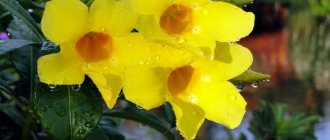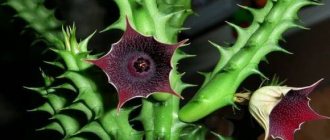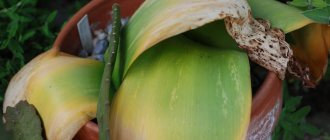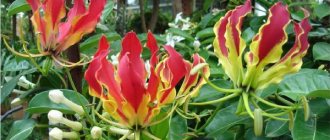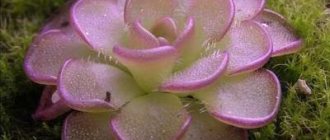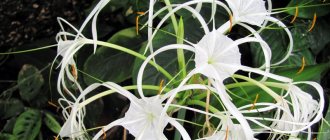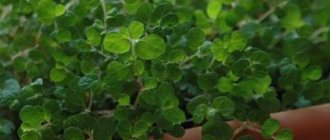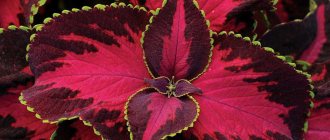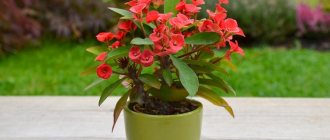View – Brovallia is beautiful
A relative of the petunia, Browallia , called Browallia in Latin, belongs to the Solanaceae . Browallia is native to Colombia, Central and South America.
Only one species is grown indoors - beautiful Browallia , called Browallia speciosa in Latin. In nature, this perennial species grows up to 1.5 meters in height. In indoor conditions, Browallia is a compact bush up to 35 cm high, which branches well and blooms profusely.
For the growth of new shoots, it is very important to pinch the plant in time, that is, cut off the tops of the branches. Beautiful Browallia is very common and is loved by gardeners as a potted plant, but it can also decorate a summer balcony.
The main charm of brovallia lies in the beautiful flowers of white, blue, lilac or blue-violet, as well as all sorts of shades of purple. If you properly care for the plant, browallia will simply be strewn with bright and very delicate flowers.
Flower growers will also be pleased by the fact that browallia blooms for a surprisingly long time. Its flowering can last up to 16 or 18 months at a time! Even winter does not prevent brovallia from blooming, except that due to lack of light the flowering will not be as abundant.
When the plant has bloomed , we can assume that the time has come for it to grow old. As a rule, re-blooming does not happen, because Browallia lives for only two years and then dies. But this is not scary - you can constantly renew the plant by propagating it from a faded bush, which is not at all difficult.
It should be remembered that browallia contains toxic substances . Therefore, the plant should be placed away from children and pets.
Origin and appearance of Brovallia
Browallia is a member of the large nightshade family. Potatoes and tomatoes are related to this flower. And these plants have a common homeland: they are all natives of the South American continent. But unlike its tasty and healthy relatives, Brovallia does not have gastronomic advantages. It pleases only aesthetic taste. The beauty of Browallia is not as striking as that of other tropical inhabitants. This is not a bright fireworks of colors and shapes, but a simple but charming beauty. Only a true connoisseur of the flower world will understand the grace of brovallia.
The beauty of brovallia is dim, but very delicate
In the wild and in the garden, Browallia shoots can grow up to one and a half meters. When kept indoors, the bush does not exceed 30–40 cm. Compact hybrid forms are grown in open ground - in flower beds or alpine hills, and in containers to decorate terraces and balconies.
In its natural environment, browallia is a lushly flowering herbaceous shrub with shoots up to one and a half meters
Browallia is a herbaceous plant, it has tender shoots that creep or droop. Small (up to 5 cm) thin oval-shaped leaves with slight pubescence. The stems are richly decorated with flowers that form in the axils and tips. Five or six petals fused at the base with edges slightly bent back, reminiscent of both an asterisk and a violet. Their color varies from dark violet to snowy white.
Brovallia flowers look like violets, but are completely devoid of scent.
Browallia is a self-pollinating plant. Its fruits look like a box; small dark seeds are hidden behind the valves. They are easy to obtain at home, but ripening the fruits takes away the strength needed for flowering.
Browallia was named in honor of fellow naturalist Carl Linnaeus. D. Brovall was a clergyman who was interested in botany and floriculture.
Browallia is not the most difficult flower to care for. Although you can’t call her very unpretentious. It is demanding when it comes to watering and needs high air humidity when living in a room. In addition, the bush must be shaped to preserve its decorative effect. Due to the rapid flowering, it quickly stretches out, loses its attractiveness and blooms more modestly.
Browallia is still a rare plant in our apartments, but lovers have already appreciated this delicate flower
Often, after the last flowers have withered, the plant is thrown away and a new one is grown from cuttings or seeds. I must say, Brovallia reproduces easily. By the way, it blooms beautifully at any time of the year. For winter flowering it must be sown in summer, and for summer flowering - at the end of winter. By following some rules, you can try to extend the life of browllia after flowering for a year or two.
After flowering, indoor brovallia is renewed, but you can try to save the old plant
When caring for brovallia, be careful: the plant is moderately toxic. Wear gloves before working and wash your hands after completing work. Place brovallia in places inaccessible to small children and animals.
Charming browallia is a toxic plant, follow safety rules when working with it
Types and varieties of Brovallia
Browallia is a small genus, with only 6 species. Only half of them and hybrid varieties are used in floriculture. They are better suited to being kept in a room and are distinguished by a variety of colors and size of flowers.
- Browallia beautiful, or magnificent, pleasant, is the most common species in home floriculture. In the wild, it is distributed in Colombia and Peru. The cultivated variety does not grow more than 40 cm. Its fleecy shoots will branch strongly with regular pinching. The leaves are also pubescent, dark green, about 6 cm in length. Flowers up to 3 cm in diameter can be blue, blue or violet with a light center. Flowering lasts for a year or more.
- Browallia americana (or pubescent) is more hairy than other species. This plant blooms profusely and for a long time. The inflorescences are small (about 2.5 cm), solitary, violet or bluish in color. The bush is about 60 cm long and branches heavily.
- Browallia grandiflora comes from Peru. The branched bush stretches up to half a meter; in nature it blooms from late autumn. The inflorescences are large, up to 5 cm in diameter, pale blue or white, collected in loose racemes.
- Brovallia sticky is a Peruvian, medium-sized plant, about 30 cm. It got its name from its sticky stem covered with hairs. Small flowers, dark blue with a white center or snow color, are formed very abundantly. In the garden, flowering continues from mid-summer until frost. At home it blooms in November.
- Alba is a variety of sticky Brovallia with bright white inflorescences with a yellow eye. The plant is well adapted to indoor cultivation.
- Sapphire is a variety with a miniature (20 cm) bush and a head of large flowers. Their coloring resembles the gemstone after which the plant was named. Blue-blue inflorescences decorate this browllia all year round.
- Browallia Blue Bell is a modern hybrid that is more unpretentious than the original species. The spherical bush reaches 35 cm. Buds are formed 3 months after sowing. The flowers are about 3 cm in diameter, they are colored in different shades of blue and form clusters at the ends of the shoots or in the axils.
- Browallia Marine Bell is a compact hybrid. The flowers are small (2 cm) of a deep blue hue and bloom very quickly, two months after sowing the seeds.
- Browallia Silver Bell is a hybrid variety. The leaves are rich green, more durable than other varieties. Flowers in the shape of a five-pointed star (diameter 3 cm) are snow-white.
Browallia is beautiful, American, sticky and varieties in the photo
Browallia Silver Bell: flowers like snow-white stars
Brovallia Sapphire - quite large flowers on a small bush
Browallia Marine Bell with blue-violet flowers
Browallia grandiflora has inflorescences with a diameter of 5 cm
New varieties have been bred based on the beautiful Brovallia
Brovallia sticky has very fuzzy stems and small flowers.
Browallia Blue Bell - an unpretentious and compact flower
Browallia americana is distinguished by its small flowers with specially fused petals.
Alba variety is suitable for indoor keeping
Growing Brovallia from Seeds
be propagated by seeds almost all year round. The most convenient time for sowing is August to decorate an apartment with a plant, or February or March to place brovallia on the balcony or in the garden for summer flowering.
To speed up germination before sowing, it is useful to soak brovallia seeds in warm water for 2 days.
The soil for sowing seeds and adult plants should be loose and peaty. Beginner gardeners can use a ready-made substrate for flowering plants, and experienced gardeners can create a mixture themselves from:
- 1 part of turf land;
- 1 part humus soil;
- 1 part leaf soil;
- 1 part coarse sand.
In a bowl with large drainage holes, you need to pour a layer of drainage made of pebbles or brick chips 1 - 3 cm high.
Next, you should fill the container with soil, compact it with your hand and moisten it properly.
If you are not sure of the sterility of the soil, you can additionally spill it with a weak (pale pink) solution of potassium permanganate, making sure to allow the water to drain through the drainage holes.
This will protect the soil from fungal growth and speed up seed germination.
seeds should be sown superficially, without burying them in the ground. You can also lightly sprinkle them with soil.
Next, you need to sprinkle the seeds with water from a spray bottle. The bowl with the seeds should be covered with glass or a plastic bag, creating a “greenhouse” to maintain constant humidity, and placed on a bright window.
Before the seeds germinate, you need to ventilate them daily, opening the greenhouse for an hour or two, remove condensation on the glass or bag and make sure that the temperature is from +18 to +25 °C.
If everything is done correctly, the first shoots will appear in 10 or 14 days. When all the seedlings have sprouted and become a little stronger, they should be transplanted one at a time into small and narrow pots with a diameter of 5 to 7 cm.
After the appearance of 1 or 2 true leaves, which grow after the cotyledons, the seedlings need to be pinched.
When the weather becomes warm outside, it is recommended to plant young plants in balcony boxes. And when kept indoors, for greater decorativeness and splendor of the bush, you can plant 4 seedlings in one pot.
Reproduction
In winter or early spring, brovalia is grown from seeds, but this plant can be propagated by cuttings in spring and summer.
The process of obtaining a young plant from cuttings looks like this:
- Cuttings are cut from the ends of shoots without buds and flowers.
- After treatment with a growth stimulator, they are planted in a tray with soil and covered with glass.
- The plantings are ventilated daily and the soil is moistened as needed.
- After the seedlings begin to grow, they are planted in separate pots.
The process of propagating brovallia by cuttings is even simpler than growing this flower from a seed. In addition, you can get a young plant in a shorter time.
Choosing a location and lighting
Browallia is a light-loving plant that does not tolerate the direct rays of the scorching sun. The ideal place for it is the east window. The plant will also like to live on the eastern balcony, where it will be provided with shade in the summer heat.
Brovallia requires a moderate temperature , as the plant does not do well in the heat. In spring and summer, the ideal option is +20 °C, and in winter during flowering - about +18 °C.
If in winter the young plant has not yet had time to bloom, it is necessary to overwinter it at +10+15 °C. The same should be done with an old plant that is planned to be propagated.
Care
The list of care requirements and activities is quite simple. It is enough to follow certain rules, and the beautiful Browallia will bloom at home all year round. The plant needs regular watering and fertilizing, as well as certain temperature and humidity levels.
What is the name of an indoor flower with red leaves?
The basic rules are listed in the table:
| Light | Prefers well-lit places, but must be shaded from direct sunlight. |
| Temperature | It grows and develops well at normal room temperature - 20 degrees. Considering the year-round flowering, it does not require lowering the temperature in winter. |
| Watering | The entire development period, except winter time, requires frequent watering. Does not tolerate waterlogging. |
| Humidity | At low humidity, spray, but so as not to wet the flowers. |
| Fertilizers | Fertilizers are applied regularly, especially in the spring and summer. Ready-made mixtures are used as fertilizer. |
| The soil | Nutritious soil that conducts air and water well is required. It is best to purchase ready-made ones at a garden center. |
In addition to care measures, it is also necessary to choose the right pot.
You should anticipate how the plant will grow and choose the appropriate size. This is especially true for transplanting after picking young bushes. Important! To stimulate branching of shoots and the formation of new flowers, pinching the tops is carried out.
An interesting fact is that browallia is an indoor flower that does not need to be replanted. It simply fades and is replaced with a new specimen.
Watering and humidity
In the summer, brovallia needs abundant watering , and in winter - very moderate . It is extremely dangerous to be too zealous with watering - excess moisture leads to rotting of the roots.
Brovallia will not refuse high air humidity, but can adapt to normal room conditions. The plant will be very grateful if you spray it regularly.
We answer the question: how to plant basil at home so that there is greenery on the table all year round?
Caring for the beautiful fuchsia rewards you with lush flowering. Read more here.
Bright gloxinia will charm you with its colors https://sad-doma.net/houseplants/dekarativnotsvetushhie/gloksiniya/gloksiniya-uhod.html, if you follow the rules for caring for it.
Diseases and pests of Browallia: control measures and prevention (table)
| How does it manifest? | Disease or pest | What to do? | Prevention measures |
| A coating similar to flour appears on the leaves, stems and flowers. The affected parts of the plant wither. | Powdery mildew. | Remove affected leaves and flowers. Treat the plant with Topaz or iodine solution (1 ml per 350 ml of water). | Overmoistening of the soil is one of the fungal causes of diseases. Stale air promotes their development. To avoid infection, adjust watering and ventilate the room more often. Keep new plants in quarantine. |
| The plant loses its tone and withers, but the soil is moist. | Root rot. |
| |
| Dark rotting spots appear on the leaves and stems, often at the bottom. | Stem rot. | If decay has only affected the plant, you can try to save it. Root healthy tip cuttings. Inspect the roots; if they are healthy, but the trunk is not damaged near the soil, you can cut it off. Sprinkle the cut with coal or sulfur. Spray what remains in the pot with the stimulant solution and cover with a bag. Perhaps buds will wake up on the stump. If the damage is significant, the plant must be discarded and its neighbors treated with a fungicide. | |
| The leaves are elastic, but turn pale and yellow. | Chlorosis. | Water and spray with ferrovite, iron chelate (antichlorosine) until healthy leaves appear. It is advisable to replant in fresh soil. | Fertilize the plant in moderation, water only with demineralized (settled) water. |
| The leaves are covered with yellowish spots and dots, sometimes a white cobweb is visible. The foliage is dying. | Spider mite infestation. | Spray the browllia with a systemic insecticide, phytoferm, actellik, derris. | Inspect the plant regularly to detect the first signs of pest infestation and take action on time. Spray the plant regularly. Humidify the air and ventilate; spider mites and other pests breed in dry and stuffy rooms. |
| The leaves wither, there are greenish larvae on the underside, and flying whitish insects around. | Whitefly attack. |
| |
| Browallia grows poorly, the leaves are limp even after watering. Small whitish lumps, similar to cotton wool, and a sticky coating are noticeable. | Mealybug attacks. | Isolate the infected flower; the worm easily spreads to other plants. Remove pests by hand using a damp cloth. After this, spray or rinse with a soap-alcohol solution (20 g of laundry soap and 20 ml of alcohol per 1 liter of hot water). If the lesion is massive, treat with fufanon, actara or actellik insecticides. |
Pests
Brovallia can become a favorite treat for: spider mites, whiteflies, mealybugs, scale insects.
As you can see, browallia is a surprisingly unpretentious plant that blooms almost all year round. Caring for brovallia does not cause any problems and even a beginner can do it. Growing Brovallia from seeds at home is as easy as inhaling.
By renewing the plant every year, you can endlessly enjoy the lush greenery of the bush and charming scatterings of flowers.
And for those who like to know everything, we invite you to familiarize yourself with the video tutorial about brovallia.
Possible problems when caring for browalia
- Infection with mealybugs or spider mites - extremely dry and warm indoor air.
- Powdery mildew appears when the substrate is waterlogged.
- The occurrence of chlorosis, in which the leaves of the plant turn yellow, is caused by a lack of iron in the soil.
- The appearance of whitefly, aphid, and scale insect larvae on the plant can occur when the flower is left in the open air.
- The leaves are wilting - the room is too warm.
- The plant is frail, has pale leaves - lack of lighting.
- Yellow spots on the leaves are sunburn.
Attention! Brovalia needs sanitary pruning, that is, timely removal of dry stems and wilted flowers. For greater bushiness, pinching the tops of the shoots is recommended.
Planting and transplanting
Experts believe that it is undesirable to replant plants during flowering unless absolutely necessary. But Browallia tolerates a full transplant extremely poorly. The maximum that can be done, if necessary, is transshipment, that is, moving the plant with its own lump into a larger container. It is advisable to carry out this procedure before flowering begins. When propagating, planting is carried out in a specially prepared soil mixture.
What conditions are required depending on the season - table
To successfully grow brovallia from seeds at home, the crop should be provided with proper care.
Lighting
Brovalia will grow from seeds at home only if the plant is provided with sufficient light.
Important! Despite the fact that the flower loves illuminated places, it does not tolerate direct sunlight very well.
Location
If possible, it is recommended to place the pot with the plant near a window facing east.
Temperature
Despite its tropical roots, the indoor flower Browallia does not like too high temperatures. If you do not pay due attention to the temperature regime in which the plant will be kept, you can forget about what the flowers of the crop look like.
The brovalia flower feels most comfortable when caring and propagating at 20 degrees in the summer and at 15 degrees in the winter. In cool conditions, the plant inevitably slows down its growth, but its lifespan is somewhat extended.
Watering and humidity
The flower, regardless of the variety, cannot tolerate dry air, so keeping it indoors without additional spraying is unacceptable. The plant must be moistened daily.
Important! When spraying brovallia during the flowering period, you should never get water on the petals, otherwise brown spots will appear on them.
The plant should be watered regularly, but not too much. Do not allow the soil in the pot to dry out or allow excess moisture to accumulate in it.
To grow brovallia indoors, the easiest way is to purchase universal soil. If the plant is planned to be planted not in the house on the windowsill, but in open ground, the substrate can be prepared by mixing turf soil, leaf soil and sand in equal parts.
Planting a flower in soil that is overly moist and oversaturated with nutrients is not recommended. In this case, even if you care for the plant correctly, it is unlikely that you will be able to wait for flowering - only greenery will actively develop.
Important! The best option for planting a flower is well-drained garden soil with average fertility.
READ MORE: Living room design in Khrushchev 73 photos of how to furnish a small room - real examples of the interior of a hall with an area of 18 meters
Seedlings should be planted at a distance of at least 30 and no more than 35 cm from each other - only in this case will it be possible to form a border without bald spots. If there is a need to slightly delimit the bushes, the distance between the bushes can be increased to 40-45 cm.
Diseases and pests
In general, Browallia has good immunity to most diseases. But when growing a plant in an overly humid environment or at too high a temperature, there is a high likelihood of developing symptoms of powdery mildew. If you find a grayish coating on the shoots and leaves, you should immediately treat the flower with fungicides. It is better to initially follow the rules of care and provide the crop with optimal conditions for growth.
As for harmful insects, spider mites, aphids and scale insects are especially dangerous for indoor flowers. The most effective way to combat them is with insecticides and spraying (washing) with a solution of laundry soap.
Interesting. If the flower is grown in close proximity to plants with a specific smell (for example, geranium), the likelihood of pests will be significantly reduced.
The value of brovallia is its long flowering (13-18 months), which is not often found among indoor flower plants. The flower spends a lot of energy on such a life cycle, but proper care helps it recover.
Care stages:
- Temperature conditions. Depending on the season, the temperature varies from 25°C in summer, to 15°-18°C in winter and 20°C in autumn and spring. You can maintain the desired temperature by moving the pot with the plant to the balcony, to the windowsill, or, conversely, removing it from there to a warmer room.
- Humidity. Tropical plants grow in a humid environment, so the air in the room can be humidified using a spray bottle or installing a container of water. It is not recommended to spray the bush itself, since drops of water may cause stains on the flowers.
- Illumination. If there is insufficient lighting, flowering may not occur, but direct sunlight is also undesirable - the light should be diffused. On sunny, hot days, protection from the sun should be provided, and in winter, if necessary, the plant should be illuminated.
- Water generously on hot sunny days and moderately in winter and autumn. The container must have a drainage hole and a drainage layer to avoid moisture stagnation.
- It is necessary to apply fertilizing (every 14 days) to replenish nutrients in the soil - ready-made complexes without nitrogen for indoor flowering plants are suitable. The recommended dosage should be reduced by 2-3 times.
- Trimming and pinching. To form a bush of a beautiful, regular shape, you need to regularly pinch the top of the shoots, trim off dried stems and remove faded flowers.
- Diseases. If signs of powdery mildew appear (grayish coating on leaves and shoots), treat with a fungicide (Topaz, Skor) or, in case of severe damage, remove the plant so that the infection does not spread to neighboring plantings. The disease appears in too humid environments and high temperatures, so care must be followed.
- Pests. For indoor plants, aphids, thrips, scale insects and red spider mites are dangerous. Special preparations (Intavir, Oktara), a solution of laundry soap (spraying, washing with a sponge), and growing nearby plants with a specific smell, for example, geraniums, marigolds, help fight them.
Proper care of your brovallia will give you a beautiful flowering bush.
This is perhaps the most difficult of all care items. During the growing season and flowering, the soil should always be slightly moist. But excessive moisture can cause rotting of the root system and stems, which can destroy the plant. An overdried plant will not recover either.
Brovallia does not like frequent and scanty watering
Fertilizers
It is necessary to feed brovallia, which grows and blooms profusely in a pot. From May, the plant is fertilized once every 2 weeks with complex compounds for flowering plants, slightly reducing the specified concentration. In the fall, feeding is stopped.
Flowering period
Unlike other indoor flowering plants, the flowering of brovallia can be called long-lasting. In open ground, it blooms flowers in mid-summer - in July, but will delight the eye until frost. Plants in closed ground can bloom for almost 1.5 years.
Brovallia blooms, barely having time to take root. It is advisable to pinch off the first buds so that the bush acquires greater splendor and becomes stronger. And one more secret - faded buds must be removed in a timely manner, not allowing fruit to set. This way you prolong flowering.
Unfortunately, after flowering you will have to part with the old plant.
To maintain lush flowering of brovalia, it needs to be fed
This is a mandatory procedure to maintain the decorative appearance of brovallia. Constantly pinching the tops of young shoots enhances shoot formation and forms a lush bush. Also, do not forget to trim dried stems and flowers in a timely manner.
Rest period
Brovallia does not have a rest period. There is a period when the plant has faded and fruits and seeds begin to form on it. At this time, the flower is kept in a bright, cool place, without fertilizing, but watering it moderately.
